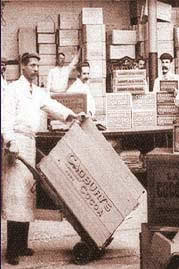Smithsonian Magazine has a great little article on the history of chocolate. I knew that it was primarily a drink for most of its history, but I didn’t realize it only was made a solid only after the Dutch process made a powder from chocolate liquor.
In 1828, a Dutch chemist found a way to make powdered chocolate by removing about half the natural fat (cacao butter) from chocolate liquor, pulverizing what remained and treating the mixture with alkaline salts to cut the bitter taste. His product became known as “Dutch cocoa,” and it soon led to the creation of solid chocolate.
The creation of the first modern chocolate bar is credited to Joseph Fry, who in 1847 discovered that he could make a moldable chocolate paste by adding melted cacao butter back into Dutch cocoa.
By 1868, a little company called Cadbury was marketing boxes of chocolate candies in England. Milk chocolate hit the market a few years later, pioneered by another name that may ring a bell – Nestle.

So it seems the cream egg is the least of Cadbury’s accomplishments.
John Cadbury, incidentally, was a Quaker of notable social consciousness who went into the chocolate/coffee/tea beverage business out of Temperance Society idealism.
The Cadbury’s site has an excellent history section itself, both of the company and of the bean.




